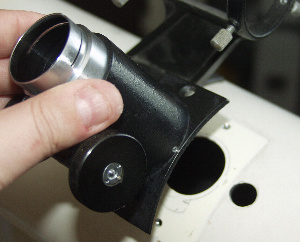 |
 |
 |
| Remove the three screws that hold the telescope rear
plate into the tube. CAUTION - do not undo these screws without either
supporting the rear plate or having the telescope facing downwards. The rear
element contains the mirror and is quite heavy and you don't want it dropped
onto the floor. |
With the three screws removed and the telescope tube
facing slightly downwards you can now VERY GENTLY remove the rear cell of the
telescope. |
Here is the rear cell removed showing the mirror cell
and within it the primary mirror. |
| |
|
|
 |
 |
 |
| The face of the primary mirror. On this scope the mirror
was very dirty and covered in dust. |
To remove the mirror cell and the mirror place the
entire rear cell face down on a hard, completely flat and clean surface such as
a worktop covered with paper. The mirrors retaining clips will stop the mirror
coming into contact with anything IF the surface is perfectly flat. |
Remove the main collimating screws from the rear of the
cell. |
| |
|
|
 |
 |
 |
| With all three main collimating screws removed the rear
plate will simply disengage from the mirror cell. Be careful not to lose the
small springs which form part of the assembly. |
Here is one of the main collimating screws along with
its tension spring. |
The primary mirror can be removed from its cell by using
two screwdrivers to VERY CAREFULLY unscrew the large locking ring. This is very
much a job for two pairs of hands and a fair degree of caution. |
|
|
|
 |
 |
 |
| Close up of a screwdriver tip located into the large
locking ring cut out. |
With patience and care the locking ring can be unscrewed
and removed. This one had a large amount of corrosion. |
Underneath the locking ring is a large spring tensioner.
Remove this. It should pull free with no trouble. |
| |
|
|
 |
 |
 |
| Another view of the spring tensioner being
removed. |
Now gently turn the mirror cell over while holding the
back of the mirror to stop it falling out prematurely. Once the mirror cell is
facing upwards (mirror clips up) very gently tap the mirror cell/carrier and
pull it away CAREFULLY. The mirror should simply drop out. |
Here is the mirror successfully removed from the
carrier. Place this somewhere safe ready for cleaning. I usually use a
tupperware box lined with acid free paper. |
| |
|
|
 |
 |
 |
| Remove the 4 screws that hold the spider vanes in place.
Be careful that the telescope is laying flat for this part of the job and keep
a hold on the spider in case it topples over and damages the secondary
mirror. |
With all four screws and the surrounding caps removed
the secondary can be jiggled free of the tube. |
Now remove the secondary mirror by unscrewing the centre screw. If
this is tight loosen off the three surrounding 'tilt adjuster' screws. Exercise
care because its easy to bend or break the spider vanes. |
| |
|
|
 |
 |
 |
| Mirror removal. Note the position of the secondary
mirror tension spring. The wider part faces towards the secondary
mirror |
A close up of the secondary mirror tension
spring. |
The focuser is now removed using the screws above and
below the focuser |
| |
|
|
 |
 |
 |
| The focuser being removed from the telescope
tube. |
Similarly the finder scope bracket can simply be removed
by taking out the two screws on either side of it. |
The finder bracket being removed. |
| |
|
|
 |
 |
 |
| The telescope tube is now bare and ready for any rework or
repainting. |
All small elements are stored in containers and optical
elements are put aside in safe containers ready for cleaning. |
The tube is marked here for rework. The focuser cut out
is to be enlarged. |
| |
|
|